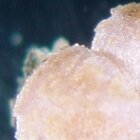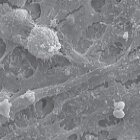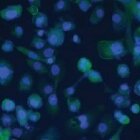Oncogenomics
Oncogenomics research articles, Oncogenomics research article, Oncogenomics journals, Oncogenomics journal, Oncogenomics articles, Research on Breast cancer, Oncogenomics




 Latest news
Latest news
- Call for papers for Analytical Chemistry Insights from Dr Gabor Patonay
-
- 22/Sep/2009
- No article processing fees for selected journals
-
- 15/Sep/2009
- Newsletter summary (week 36, 2009)
-
- 15/Sep/2009
- Interview with Healthy Aging and Clinical Care in the Elderly editorial board member Dr Davide Malatesta
-
- 15/Sep/2009
- Interview with Translational Oncogenomics author Dr David Frank
-
- 10/Sep/2009
- Interview with Retrovirology: Research and Treatment author Dr Elcio Leal
-
- 10/Sep/2009
- Interview with Microbiology Insights author Dr Tinatin Doolotkedlieva
-
- 10/Sep/2009
- Call for papers for Drug Target Insights by Dr Monica Milani
-
- 10/Sep/2009
- Call for papers for Clinical Medicine: Urology from Dr Xiangyi Lu
-
- 10/Sep/2009
- Research profile on Gene Regulation and Systems Biology author Dr Noboru Uchide
-
- 09/Sep/2009
- Interview with Biomarker Insights editorial board member Dr Lawrence Cheskin
-
- 07/Sep/2009
- Newsletter summary (week 35, 2009)
-
- 04/Sep/2009
- Research profile of Clinical Medicine: Endocrinology and Diabetes author Dr Hiro Koshiyama
-
- 04/Sep/2009
- Open access articles published in August
-
- 03/Sep/2009
- Call for papers for Clinical Medicine: Circulatory, Respiratory and Pulmonary Medicine from Dr Hussein Foda
-
- 03/Sep/2009
- Interview with Cancer Informatics editorial board member Dr Georgios S. Stamatakos
-
- 03/Sep/2009
- Announcing mobile Libertas Academica website
-
- 02/Sep/2009
- Call for papers for Particle Physics Insights from Dr Hanna Moussa
-
- 02/Sep/2009
- Call for papers for Clinical Medicine: Dermatology from Dr Robert Pearl
-
- 01/Sep/2009
- Interview with Immunotherapy Insights editorial board member Dr Stéphanie McArdle
-
- 01/Sep/2009
- Interview with Cell Communication Insights editorial board member Dr John S Torday
-
- 01/Sep/2009
- Interview with Translational Oncogenomics editorial board member Dr James Connor
-
- 31/Aug/2009
- Interview with Glycobiology Insights editorial board member Dr Alberto Passi
-
- 31/Aug/2009
- Newsletter summary (week 34, 2009)
-
- 27/Aug/2009

 Latest articles
Latest articles
- Metabolic Complications of Bypass Surgery for Morbid Obesity
- Collaboration to Meet a Therapeutic Need: The Development of Nelarabine
- Taxonomy of Bacteria Nodulating Legumes
- Hemangioma of the Thyroid
- Good News from Aliskiren?
- The Influence of Traditional Herbal Medicine (Kampo) on Anti-cyclic Citrullinated Peptide Antibody Levels
- Present and Prospective Pharmacotherapies in Pulmonary Arterial Hypertension
- Tigecycline in the Treatment of Community-Acquired Pneumonia
- Pharmacotherapy of Chronic Hepatitis B in Adults: Focus on Tenofovir Disoproxil Fumarate
- Stress Cardiomyopathy (Takotsubo Cardiomyopathy)
- Safety and Efficacy of Didanosine Enteric-Coated Capsule in Patients with HIV-1 Infection
- Anatomical and Functional Organization of Inhibitory Circuits in the Songbird Auditory Forebrain
- Aliskiren for the Treatment of Hypertension: An Update
- Montelukast: Pharmacology, Safety, Tolerability and Efficacy
- The Metastasectomy and Timing of Pulmonary Metastases on the Outcome of Osteosarcoma Patients
- Rosiglitazone Maleate and Metformin Hydrochloride in Fixed Combination: What Role in the Treatment of Type 2 Diabetes?
- Pharmacotherapy of Bone Loss in Postmenopausal Women: Focus on Denosumab
- Adenomatoid Tumor of Testis
- The Evolution of Cell Communication: The Road not Taken
- Ropinirole in the Treatment of Restless Legs Syndrome
Most read articles
- Current Status of Monocyte Differentiation-Inducing (MDI) Factors Derived from Human Fetal Membrane Chorion Cells Undergoing Apoptosis after Infl uenza Virus Infection
- Relationship Between the Plasma Concentration of C-Reactive Protein and Severity of Peripheral Arterial Disease
- Intraspecific ITS Variability in the Kingdom Fungi as Expressed in the International Sequence Databases and Its Implications for Molecular Species Identification
- A Simple Derivation of the Distribution of Pairwise Local Protein Sequence Alignment Scores
- Mammoth and Elephant Phylogenetic Relationships: Mammut Americanum, the Missing Outgroup
- DICOM Structured Reporting and Cancer Clinical Trials Results
- Evaluation of Two Outlier-Detection-Based Methods for Detecting Tissue-Selective Genes from Microarray Data
- Systems Biology-Based Identification of Crosstalk between E2F Transcription Factors and the Fanconi Anemia Pathway
- Exploring the Evolutionary History of the Differentially Expressed Genes between Human Populations: Action of Recent Positive Selection
- On the Adaptive Design Rules of Biochemical Networks in Evolution
- Fast Genes and Slow Clades: Comparative Rates of Molecular Evolution in Mammals
- Phylogenetic diversity (PD) and biodiversity conservation: some bioinformatics challenges
- Identification and Quantitation of Asparagine and Citrulline Using High-Performance Liquid Chromatography (HPLC)
- Identification of Conflicting Selective Effects on Highly Expressed Genes
- In Silico Promoter Analysis can Predict Genes of Functional Relevance in Cell Proliferation: Validation in a Colon Cancer Model
(previous 30 days)Site updates
Journal: Translational Oncogenomics
Journal: Cancer Growth and Metastasis
Li-Xuan Qin Department of Epidemiology and Biostatistics, Memorial Sloan-Kettering Cancer Center, New York, New York, U.S.A. Abstract Background: MicroRNAs are believed to play an important role in gene expression regulation. They have been shown to be involved in cell cycle regulation and cancer. MicroRNA expression profiling became...
The myelodysplastic syndromes (MDS) are clonal stem cell disorders, characterized by ineffective and dysplastic hematopoiesis. The genetic and epigenetic pathways that determine disease stage and progression are largely unknown. In the current study we used gene expression microarray methodology to examine the gene expression differences between normal hematopoietic cells and...
Protein Multifunctionality: Principles and Mechanisms (15/May/2008)
In the review, the nature of protein multifunctionality is analyzed. In the first part of the review the principles of structural/functional organization of protein are discussed. In the second part, the main mechanisms involved in development of multiple functions on a single gene product(s) are analyzed. The last part represents...
Sirtuins are NAD+-dependent histone deacetylases (Class III HDACs). Recently, Sirtuins have been shown to play important roles, both direct and indirect, in transcriptional regulation. This transcriptional control, through incorporation of Sirtuins into transcription complexes and deacetylation of histones locally at gene promoters, or direct interaction with specific transcription factors, is...
Indira Poola1, Jessy Abraham1, Aiyi Liu3, Josephine J. Marshalleck2 and Robert L. DeWitty1 1Department of Surgery and Breast Center and 2Pathology, Howard University School of Medicine, Washington, DC 20059, and 3Biometry and Mathematical Statistics Branch, National Institute of Child Health and Human Development, National Institutes of Health, Bethesda, MD...
The MUC1 Cytoplasmic Tail and Tandem Repeat Domains Contribute to Mammary Oncogenesis in FVB Mice (17/Apr/2008)
Christine L. Hattrup1,3, Judy M. Bradley, Kari L. Kotlarczyk, Cathy S. Madsen, Joseph G. Hentz, Ronald J. Marler2 and Sandra J. Gendler1 1Department of Biochemistry and Molecular Biology, 2Department of Molecular Pharmacology and Experimental Therapeutics, Mayo Clinic College of Medicine, Mayo Clinic Arizona, 13400 E. Shea Boulevard, Scottsdale, Arizona,...
Implication of Ceramide, Ceramide 1-Phosphate and Sphingosine 1-Phosphate in Tumorigenesis (10/Apr/2008)
In the last two decades there has been considerable progress in our understanding of the role of sphingolipids in controlling signal transduction processes, particularly in the mechanisms leading to regulation of cell growth and death. Ceramide is a well-characterized sphingolipid metabolite and second messenger that can be produced by cancer...
Gene associated with retinoid-interferon-β-induced mortality (GRIM)—19, was originally identifi ed as a critical regulatory protein necessary for Interferon-β-Retinoic acid-induced cell death. Overexpression of GRIM-19 activates cell death and its suppression or inactivation promotes cell growth. GRIM-19 targets multiple proteins/pathways for exerting growth control and cell death. However, GRIM-19 is also...
Obesity, Adipocytokines and Cancer (17/Mar/2008)
A great amount of literature has demonstrated a connection between obesity, visceral fat and the metabolic disorders such as hyperglycemia, hypertension, and hyperlipidemia. Lately, there has been an increased interest in understanding if cancer is related to obesity and visceral fat accumulation. The prevalence of both obesity and cancer are...
Sudeep K. Bose, Rebecca S. Bullard and Carlton D. Donald Department of Pathology and Laboratory Medicine, Medical University of South Carolina (MUSC), 165 Ashley Avenue, PO Box 250620, Charleston, SC—29425, U.S.A. Abstract Prostate cancer is the second leading cause of cancer death among men in the United States...
Possible Imprinting and Microchimerism in Chronic Lymphocytic Leukemia and Related Lymphoproliferative Disorders (10/Feb/2008)
Viggo Jønsson1, Geir E. Tjønnfjord2, Tom B. Johannesen3, Sven Ove Samuelsen4 and Bernt Ly5 1Department of Hematology, Aker University Hospital, University of Oslo, Norway. 2Department of Hematology, Rikshospital and Radium Hospital, University of Oslo, Norway. 3,5The National Norwegian Cancer Registry, Oslo, Norway. 4Department of Biostatistics, Faculty of Mathematics, University...
Sheng Wang and Douglas V. Faller Boston University School of Medicine, Cancer Research Center, Boston, MA, U.S.A. Abstract Tumor formation results from alterations in the normal control of cell proliferation. In the past decade, much attention in cancer research has been focused on the function of proto-oncogenes...
Six Genes Associated with the Clinical Phenotypes of Individuals with Deficient and Proficient DNA Repair (10/Feb/2008)
Tobias Gremmel1, Susanne Wild1, Winfried Schuller2, Viola Kürten3, Klaus Dietz4, Jean Krutmann1 and Mark Berneburg2 1Institut für Umweltmedizinische Forschung at the Heinrich-Heine-University gGmbH, Auf´m Hennekamp 50, D-40225 Düsseldorf, Germany.2 Molecular Oncology and Aging, Department of Dermatology, Eberhard-Karls-University, Tübingen, Germany.3 Department of Dermatology, Heinrich-Heine-University, Moorenstr. 5, D-40225 Düsseldorf, Germany.4 Department...
James V. Alvarez1, Neelanjan Mukherjee2, Arnab Chakravarti2, Pierre Robe3, Gary Zhai2, Abhijit Chakladar2, Jay Loeffler2, Peter Black3 and David A. Frank1,4 1Department of Medical Oncology, Dana-Farber Cancer Institute, 2Department of Radiation Oncology, Massachusetts General Hospital and Harvard Medical School, 3Department of Neurosurgery, Brigham and Women’s Hospital and Harvard Medical School,...
The Role of Src Family Kinases in Prostate Cancer (14/Oct/2007)
Oleg Tatarov and Joanne Edwards Section of Surgery, Division of Cancer Sciences and Molecular Pathology, University of Glasgow, Royal Infirmary, Glasgow, G31 2ER.Abstract: No abstract provided.
Urokinase-type Plasminogen Activator (uPA) is Inhibited with QLT0267 a Small Molecule Targeting Integrin-linked Kinase (ILK) (23/Jul/2007)
Nancy Dos Santos1, Golareh Habibi1, Michelle Wang1, Jennifer H. Law1, Heather N. Andrews1, Daniel Wei2, Timothy Triche2, Shoukat Dedhar3 and Sandra E. Dunn1 1Department of Pediatrics, Child and Family Research Institute, University of British Columbia, Vancouver, BC Canada. 2Department of Pathology and Laboratory Medicine, USC Keck School of Medicine, Children’s...
The Oncogene Mcts1 (19/Jul/2007)
Ali Hachem1 and Suvobroto Nandi2 1The Cancer Center of Huntsville, Huntsville, AL 35801. 2Department of Medicine, University of California San Diego. 9500 Gilman Drive, M/C 0838, La Jolla, CA 92093.Abstract: The oncogene MCTS1, discovered as an amplified product in a subset of T-cell lymphoma lines, has been implicated in cell...
Joyce Wu, Anna L. Stratford, Arezoo Astanehe and Sandra E. Dunn Laboratory for Oncogenomic Research, Departments of Pediatrics, Experimental Medicine and Medical Genetics, Child and Family Research Institute, University of British Columbia, Vancouver, British Columbia, Canada.Abstract: The Y-box Binding Protein-1 (YB-1) is a highly conserved oncogenic transcription/translation factor that is...
Muthusamy Kunnimalaiyaan, Megan R. Haymart and Herbert Chen Endocrine Surgery Research Laboratories, Section of Endocrine Surgery, Department of Surgery, The University of Wisconsin, and the University of Wisconsin Paul P. Carbone Comprehensive Cancer Center, Madison, WI, U.S.A.Abstract: There is a growing body of literature suggesting that signaling based therapy might...
Arkadiusz Welman, Jane Barraclough and Caroline Dive Cancer Research U.K., Paterson Institute for Cancer Research, University of Manchester, Wilmslow Road, Manchester M20 4BX, United Kingdom.Abstract: The increasing number of proteomic and DNA-microarray studies is continually providing a steady acquisition of data on the molecular abnormalities associated with human tumors. Rapid...
Epigenetic Markers for Bladder Cancer in Urine (22/Mar/2007)
Wun-Jae Kim1 and Yong-June Kim2 1Department of Urology, Chungbuk National University, College of Medicine and Institute for Tumor Research, 62 Kaeshin-dong, Heungduk-gu, Cheongju 361-763 South Korea. 2Department of Urology, Chungbuk National University College of Medicine, Cheongju, South Korea.Abstract: Many tumor markers for bladder cancer have been evaluated for use in...
Current Concepts on the Pathogenesis of the Hypereosinophilic Syndrome/Chronic Eosinophilic Leukemia (28/Feb/2007)
Chronic eosinophilic leukemia is a clonal disease characterized by hypereosinophilia and eosinophilia-related pathologic manifestations. Recently, the fusion gene FIP1L1/PDGFRA was found in the long arm of chromosome 4 and its expression has been shown to be associated with development of a clinical hypereosinophilic syndrome (HES) in a significant proportion of...
Background: Potassium bromate (KBrO3), used in both the food and cosmetics industry, and a drinking water disinfection by-product, is a nephrotoxic compound and rodent carcinogen. To gain insight into the carcinogenic mechanism of action and provide possible biomarkers of KBrO3 exposure, the gene expression in kidneys from chronically exposed male...
Mithramycin Targets Sp1 and The Androgen Receptor Transcription Level: Potential Therapeutic Role in Advanced Prostate Cancer (26/Feb/2007)
Multiple lines of evidence implicate over-expression and activation of the androgen receptor (AR) in the progression of prostate cancer (PC) to androgen-independence (AI) and resistance to therapy. The mechanisms leading to AR over-expression are not fully understood but binding of Sp1 to specific Sp1-binding sites in the AR promoter and...
c-Met Mutational Analysis in the Sema and Juxtamembrane Domains in Small-Cell-Lung-Cancer (25/Feb/2007)
Background: c-Met mutations play a critical role in the development and progression of primary tumors and metastases. Activation of the HGF/SF-c-Met pathway determines a poor prognosis in non-small-cell and small-cell lung cancer (SCLC) patients. Missense mutations of c-Met have been identified in SCLC patients located in the juxtamembrane (JM) and...
Conventional gene expression profiling relies on using fluorescent detection of hybridized probes. Physical characteristics of fluorophores impose limitations on achieving a highly multiplex gene analysis of single cells. Our work demonstrates the feasibility of using metal-tagged in situ hybridization for mRNA detection by inductively coupled plasma mass spectrometry (ICP-MS). ICP-MS...
Alan C. Moss1, Peter P. Doran2 and Padraic MacMathuna1,31Conway Institute of Biomolecular and Biomedical Research, School of Medicine and Medical Sciences, University College Dublin, Dublin, Ireland and Division of Gastroenterology, Beth Israel Deaconess Medical Center, Boston, U.S.A. 2General Clinical Research Unit and 3Gastrointestinal Unit, Mater Misericordiae University Hospital, Dublin 7,...







